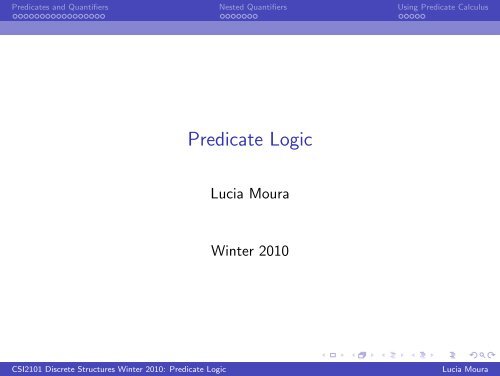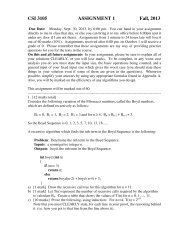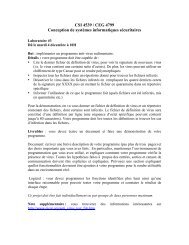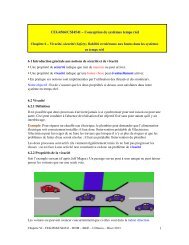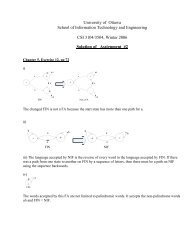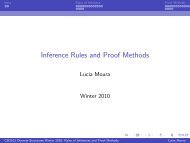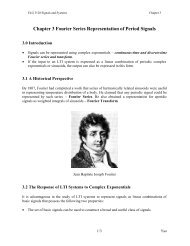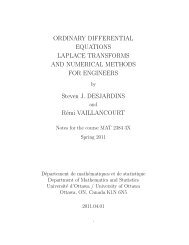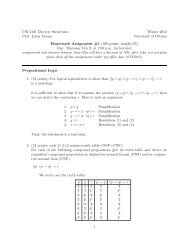Predicate Logic
Predicate Logic
Predicate Logic
Create successful ePaper yourself
Turn your PDF publications into a flip-book with our unique Google optimized e-Paper software.
<strong>Predicate</strong>s and Quantifiers Nested Quantifiers Using <strong>Predicate</strong> Calculus<br />
<strong>Predicate</strong> <strong>Logic</strong><br />
Lucia Moura<br />
Winter 2010<br />
CSI2101 Discrete Structures Winter 2010: <strong>Predicate</strong> <strong>Logic</strong> Lucia Moura
<strong>Predicate</strong>s and Quantifiers Nested Quantifiers Using <strong>Predicate</strong> Calculus<br />
<strong>Predicate</strong>s and Quantifiers<br />
<strong>Predicate</strong>s<br />
A <strong>Predicate</strong> is a declarative sentence whose true/false value depends on<br />
one or more variables.<br />
The statement “x is greater than 3” has two parts:<br />
the subject: x is the subject of the statement<br />
the predicate: “is greater than 3” (a property that the subject can<br />
have).<br />
We denote the statement “x is greater than 3” by P (x), where P is the<br />
predicate “is greater than 3” and x is the variable.<br />
The statement P (x) is also called the value of propositional function P<br />
at x.<br />
Assign a value to x, so P (x) becomes a proposition and has a truth value:<br />
P (5) is the statement “5 is greater than 3”, so P (5) is true.<br />
P (2) is the statement “2 is greater than 3”, so P (2) is false.<br />
CSI2101 Discrete Structures Winter 2010: <strong>Predicate</strong> <strong>Logic</strong> Lucia Moura
<strong>Predicate</strong>s and Quantifiers Nested Quantifiers Using <strong>Predicate</strong> Calculus<br />
<strong>Predicate</strong>s and Quantifiers<br />
<strong>Predicate</strong>s: Examples<br />
Given each propositional function determine its true/false value when<br />
variables are set as below.<br />
Prime(x) = “x is a prime number.”<br />
Prime(2) is true, since the only numbers that divide 2 are 1 and itself.<br />
Prime(9) is false, since 3 divides 9.<br />
C(x, y)=“x is the capital of y”.<br />
C(Ottawa,Canada) is true.<br />
C(Buenos Aires,Brazil) is false.<br />
E(x, y, z) = “x + y = z”.<br />
E(2, 3, 5) is ...<br />
E(4, 4, 17) is ...<br />
CSI2101 Discrete Structures Winter 2010: <strong>Predicate</strong> <strong>Logic</strong> Lucia Moura
<strong>Predicate</strong>s and Quantifiers Nested Quantifiers Using <strong>Predicate</strong> Calculus<br />
<strong>Predicate</strong>s and Quantifiers<br />
Quantifiers<br />
Assign a value to x in P (x) =“x is an odd number”, so the resulting<br />
statement becomes a proposition: P (7) is true, P (2) is false.<br />
Quantification is another way to create propositions from a propositional<br />
functions:<br />
universal quantification: ∀xP (x) says<br />
“the predicate P is true for every element under consideration.”<br />
Under the domain of natural numbers, ∀xP (x) is false.<br />
existencial quantification: ∃xP (x) says<br />
“there is one or more element under consideration for which the<br />
predicate P is true.”<br />
Under the domain of natural numbers, ∃xP (x) is true, since for<br />
instance P (7) is true.<br />
<strong>Predicate</strong> calculus: area of logic dealing with predicates and quantifiers.<br />
CSI2101 Discrete Structures Winter 2010: <strong>Predicate</strong> <strong>Logic</strong> Lucia Moura
<strong>Predicate</strong>s and Quantifiers Nested Quantifiers Using <strong>Predicate</strong> Calculus<br />
<strong>Predicate</strong>s and Quantifiers<br />
Domain, domain of discourse, universe of discourse<br />
Before deciding on the truth value of a quantified predicate, it is<br />
mandatory to specify the domain (also called domain of discourse or<br />
universe of discourse).<br />
P (x) =“x is an odd number”<br />
∀xP (x) is false for the domain of integer numbers; but<br />
∀xP (x) is true for the domain of prime numbers greater than 2.<br />
CSI2101 Discrete Structures Winter 2010: <strong>Predicate</strong> <strong>Logic</strong> Lucia Moura
<strong>Predicate</strong>s and Quantifiers Nested Quantifiers Using <strong>Predicate</strong> Calculus<br />
<strong>Predicate</strong>s and Quantifiers<br />
Universal Quantifier<br />
The universal quantification of P (x) is the statement:<br />
“P (x) for all values of x in the domain” denoted ∀xP (x).<br />
∀xP (x) is true when P (x) is true for every x in the domain.<br />
∀xP (x) is false when there is an x for which P (x) is false.<br />
An element for which P (x) is false is called a counterexample of ∀xP (x).<br />
If the domain is empty, ∀xP (x) is true for any propositional function<br />
P (x), since there are no counterexamples in the domain.<br />
If the domain is finite {x1, x2, . . . , xn}, ∀xP (x) is the same as<br />
P (x1) ∧ P (x2) ∧ · · · ∧ P (xn).<br />
CSI2101 Discrete Structures Winter 2010: <strong>Predicate</strong> <strong>Logic</strong> Lucia Moura
<strong>Predicate</strong>s and Quantifiers Nested Quantifiers Using <strong>Predicate</strong> Calculus<br />
<strong>Predicate</strong>s and Quantifiers<br />
Universal quantifiers: example<br />
Let P (x) be “x 2 > 10 ′′ .<br />
What is the truth value of ∀xP (x) for each of the following domains:<br />
CSI2101 Discrete Structures Winter 2010: <strong>Predicate</strong> <strong>Logic</strong> Lucia Moura
<strong>Predicate</strong>s and Quantifiers Nested Quantifiers Using <strong>Predicate</strong> Calculus<br />
<strong>Predicate</strong>s and Quantifiers<br />
Universal quantifiers: example<br />
Let P (x) be “x 2 > 10 ′′ .<br />
What is the truth value of ∀xP (x) for each of the following domains:<br />
◮ the set of real numbers: R<br />
CSI2101 Discrete Structures Winter 2010: <strong>Predicate</strong> <strong>Logic</strong> Lucia Moura
<strong>Predicate</strong>s and Quantifiers Nested Quantifiers Using <strong>Predicate</strong> Calculus<br />
<strong>Predicate</strong>s and Quantifiers<br />
Universal quantifiers: example<br />
Let P (x) be “x 2 > 10 ′′ .<br />
What is the truth value of ∀xP (x) for each of the following domains:<br />
◮ the set of real numbers: R<br />
◮ False. 3 is a counterexample.<br />
CSI2101 Discrete Structures Winter 2010: <strong>Predicate</strong> <strong>Logic</strong> Lucia Moura
<strong>Predicate</strong>s and Quantifiers Nested Quantifiers Using <strong>Predicate</strong> Calculus<br />
<strong>Predicate</strong>s and Quantifiers<br />
Universal quantifiers: example<br />
Let P (x) be “x 2 > 10 ′′ .<br />
What is the truth value of ∀xP (x) for each of the following domains:<br />
◮ the set of real numbers: R<br />
◮ False. 3 is a counterexample.<br />
◮ the set of positive integers not exceeding 4: {1, 2, 3, 4}<br />
CSI2101 Discrete Structures Winter 2010: <strong>Predicate</strong> <strong>Logic</strong> Lucia Moura
<strong>Predicate</strong>s and Quantifiers Nested Quantifiers Using <strong>Predicate</strong> Calculus<br />
<strong>Predicate</strong>s and Quantifiers<br />
Universal quantifiers: example<br />
Let P (x) be “x 2 > 10 ′′ .<br />
What is the truth value of ∀xP (x) for each of the following domains:<br />
◮ the set of real numbers: R<br />
◮ False. 3 is a counterexample.<br />
◮ the set of positive integers not exceeding 4: {1, 2, 3, 4}<br />
◮ False. 3 is a counterexample.<br />
CSI2101 Discrete Structures Winter 2010: <strong>Predicate</strong> <strong>Logic</strong> Lucia Moura
<strong>Predicate</strong>s and Quantifiers Nested Quantifiers Using <strong>Predicate</strong> Calculus<br />
<strong>Predicate</strong>s and Quantifiers<br />
Universal quantifiers: example<br />
Let P (x) be “x 2 > 10 ′′ .<br />
What is the truth value of ∀xP (x) for each of the following domains:<br />
◮ the set of real numbers: R<br />
◮ False. 3 is a counterexample.<br />
◮ the set of positive integers not exceeding 4: {1, 2, 3, 4}<br />
◮ False. 3 is a counterexample.<br />
◮ Also note that here ∀P (x) is P (1) ∧ P (2) ∧ P (3) ∧ P (4), so its enough<br />
to observe that P (3) is false.<br />
CSI2101 Discrete Structures Winter 2010: <strong>Predicate</strong> <strong>Logic</strong> Lucia Moura
<strong>Predicate</strong>s and Quantifiers Nested Quantifiers Using <strong>Predicate</strong> Calculus<br />
<strong>Predicate</strong>s and Quantifiers<br />
Universal quantifiers: example<br />
Let P (x) be “x 2 > 10 ′′ .<br />
What is the truth value of ∀xP (x) for each of the following domains:<br />
◮ the set of real numbers: R<br />
◮ False. 3 is a counterexample.<br />
◮ the set of positive integers not exceeding 4: {1, 2, 3, 4}<br />
◮ False. 3 is a counterexample.<br />
◮ Also note that here ∀P (x) is P (1) ∧ P (2) ∧ P (3) ∧ P (4), so its enough<br />
to observe that P (3) is false.<br />
◮ the set of real numbers in the interval [10, 39.5]<br />
CSI2101 Discrete Structures Winter 2010: <strong>Predicate</strong> <strong>Logic</strong> Lucia Moura
<strong>Predicate</strong>s and Quantifiers Nested Quantifiers Using <strong>Predicate</strong> Calculus<br />
<strong>Predicate</strong>s and Quantifiers<br />
Universal quantifiers: example<br />
Let P (x) be “x 2 > 10 ′′ .<br />
What is the truth value of ∀xP (x) for each of the following domains:<br />
◮ the set of real numbers: R<br />
◮ False. 3 is a counterexample.<br />
◮ the set of positive integers not exceeding 4: {1, 2, 3, 4}<br />
◮ False. 3 is a counterexample.<br />
◮ Also note that here ∀P (x) is P (1) ∧ P (2) ∧ P (3) ∧ P (4), so its enough<br />
to observe that P (3) is false.<br />
◮ the set of real numbers in the interval [10, 39.5]<br />
◮ True. It takes a bit longer to verify than in false statements.<br />
Let x ∈ [10, 39.5]. Then x ≥ 10 which implies x 2 ≥ 10 2 = 100 > 10,<br />
and so x 2 > 10.<br />
CSI2101 Discrete Structures Winter 2010: <strong>Predicate</strong> <strong>Logic</strong> Lucia Moura
<strong>Predicate</strong>s and Quantifiers Nested Quantifiers Using <strong>Predicate</strong> Calculus<br />
<strong>Predicate</strong>s and Quantifiers<br />
Existencial Quantifier<br />
The existential quantification of P (x) is the statement:<br />
“There exists an element x in the domain such that P (x)” denoted<br />
∃xP (x).<br />
∃xP (x) is true when P (x) is true for one or more x in the domain.<br />
An element for which P (x) is true is called a witness of ∃xP (x).<br />
∃xP (x) is false when P (x) is false for every x in the domain<br />
(if domain nonempty).<br />
If the domain is empty, ∃xP (x) is false for any propositional function<br />
P (x), since there are no witnesses in the domain.<br />
If the domain is finite {x1, x2, . . . , xn}, ∃xP (x) is the same as<br />
P (x1) ∨ P (x2) ∨ · · · ∨ P (xn).<br />
CSI2101 Discrete Structures Winter 2010: <strong>Predicate</strong> <strong>Logic</strong> Lucia Moura
<strong>Predicate</strong>s and Quantifiers Nested Quantifiers Using <strong>Predicate</strong> Calculus<br />
<strong>Predicate</strong>s and Quantifiers<br />
Existencial quantifiers: example<br />
Let P (x) be “x 2 > 10 ′′ .<br />
What is the truth value of ∃xP (x) for each of the following domains:<br />
CSI2101 Discrete Structures Winter 2010: <strong>Predicate</strong> <strong>Logic</strong> Lucia Moura
<strong>Predicate</strong>s and Quantifiers Nested Quantifiers Using <strong>Predicate</strong> Calculus<br />
<strong>Predicate</strong>s and Quantifiers<br />
Existencial quantifiers: example<br />
Let P (x) be “x 2 > 10 ′′ .<br />
What is the truth value of ∃xP (x) for each of the following domains:<br />
◮ the set of real numbers: R<br />
CSI2101 Discrete Structures Winter 2010: <strong>Predicate</strong> <strong>Logic</strong> Lucia Moura
<strong>Predicate</strong>s and Quantifiers Nested Quantifiers Using <strong>Predicate</strong> Calculus<br />
<strong>Predicate</strong>s and Quantifiers<br />
Existencial quantifiers: example<br />
Let P (x) be “x 2 > 10 ′′ .<br />
What is the truth value of ∃xP (x) for each of the following domains:<br />
◮ the set of real numbers: R<br />
◮ True. 10 is a witness.<br />
CSI2101 Discrete Structures Winter 2010: <strong>Predicate</strong> <strong>Logic</strong> Lucia Moura
<strong>Predicate</strong>s and Quantifiers Nested Quantifiers Using <strong>Predicate</strong> Calculus<br />
<strong>Predicate</strong>s and Quantifiers<br />
Existencial quantifiers: example<br />
Let P (x) be “x 2 > 10 ′′ .<br />
What is the truth value of ∃xP (x) for each of the following domains:<br />
◮ the set of real numbers: R<br />
◮ True. 10 is a witness.<br />
◮ the set of positive integers not exceeding 4: {1, 2, 3, 4}<br />
CSI2101 Discrete Structures Winter 2010: <strong>Predicate</strong> <strong>Logic</strong> Lucia Moura
<strong>Predicate</strong>s and Quantifiers Nested Quantifiers Using <strong>Predicate</strong> Calculus<br />
<strong>Predicate</strong>s and Quantifiers<br />
Existencial quantifiers: example<br />
Let P (x) be “x 2 > 10 ′′ .<br />
What is the truth value of ∃xP (x) for each of the following domains:<br />
◮ the set of real numbers: R<br />
◮ True. 10 is a witness.<br />
◮ the set of positive integers not exceeding 4: {1, 2, 3, 4}<br />
◮ True. 4 is a witness.<br />
CSI2101 Discrete Structures Winter 2010: <strong>Predicate</strong> <strong>Logic</strong> Lucia Moura
<strong>Predicate</strong>s and Quantifiers Nested Quantifiers Using <strong>Predicate</strong> Calculus<br />
<strong>Predicate</strong>s and Quantifiers<br />
Existencial quantifiers: example<br />
Let P (x) be “x 2 > 10 ′′ .<br />
What is the truth value of ∃xP (x) for each of the following domains:<br />
◮ the set of real numbers: R<br />
◮ True. 10 is a witness.<br />
◮ the set of positive integers not exceeding 4: {1, 2, 3, 4}<br />
◮ True. 4 is a witness.<br />
◮ Also note that here ∃P (x) is P (1) ∨ P (2) ∨ P (3) ∨ P (4), so its enough<br />
to observe that P (4) is true.<br />
CSI2101 Discrete Structures Winter 2010: <strong>Predicate</strong> <strong>Logic</strong> Lucia Moura
<strong>Predicate</strong>s and Quantifiers Nested Quantifiers Using <strong>Predicate</strong> Calculus<br />
<strong>Predicate</strong>s and Quantifiers<br />
Existencial quantifiers: example<br />
Let P (x) be “x 2 > 10 ′′ .<br />
What is the truth value of ∃xP (x) for each of the following domains:<br />
◮ the set of real numbers: R<br />
◮ True. 10 is a witness.<br />
◮ the set of positive integers not exceeding 4: {1, 2, 3, 4}<br />
◮ True. 4 is a witness.<br />
◮ Also note that here ∃P (x) is P (1) ∨ P (2) ∨ P (3) ∨ P (4), so its enough<br />
to observe that P (4) is true.<br />
◮ the set of real numbers in the interval [0, √ 9.8]<br />
CSI2101 Discrete Structures Winter 2010: <strong>Predicate</strong> <strong>Logic</strong> Lucia Moura
<strong>Predicate</strong>s and Quantifiers Nested Quantifiers Using <strong>Predicate</strong> Calculus<br />
<strong>Predicate</strong>s and Quantifiers<br />
Existencial quantifiers: example<br />
Let P (x) be “x 2 > 10 ′′ .<br />
What is the truth value of ∃xP (x) for each of the following domains:<br />
◮ the set of real numbers: R<br />
◮ True. 10 is a witness.<br />
◮ the set of positive integers not exceeding 4: {1, 2, 3, 4}<br />
◮ True. 4 is a witness.<br />
◮ Also note that here ∃P (x) is P (1) ∨ P (2) ∨ P (3) ∨ P (4), so its enough<br />
to observe that P (4) is true.<br />
◮ the set of real numbers in the interval [0, √ 9.8]<br />
◮ False. It takes a bit longer to conclude than in true statements.<br />
Let x ∈ [0, 9.8]. Then 0 ≤ x ≤ √ 9.8 which implies<br />
x 2 ≤ ( √ 9.8) 2 = 9.8 < 10, and so x 2 < 10.<br />
What we have shown is that ∀x¬P (x), which (we will see) is<br />
equivalent to ¬∃xP (x)<br />
CSI2101 Discrete Structures Winter 2010: <strong>Predicate</strong> <strong>Logic</strong> Lucia Moura
<strong>Predicate</strong>s and Quantifiers Nested Quantifiers Using <strong>Predicate</strong> Calculus<br />
<strong>Predicate</strong>s and Quantifiers<br />
Other forms of quantification<br />
Other Quantifiers<br />
The most important quantifiers are ∀ and ∃, but we could define<br />
many different quantifiers: “there is a unique”, “there are exactly<br />
two”, “there are no more than three”, “there are at least 100”, etc.<br />
A common one is the uniqueness quantifier, denoted by ∃!.<br />
∃!xP (x) states “There exists a unique x such that P (x) is true.”<br />
Advice: stick to the basic quantifiers. We can write ∃!xP (x) as<br />
∃x(P (x) ∧ ∀y(P (y) → y = x)) or more compactly<br />
∃x∀y(P (y) ↔ y = x)<br />
Restricting the domain of a quantifier<br />
Abbreviated notation is allowed, in order to restrict the domain of<br />
certain quantifiers.<br />
◮ ∀x > 0(x 2 > 0) is the same as ∀x(x > 0→x 2 > 0).<br />
◮ ∀y = 0(y 3 = 0) is the same as ∀y(y = 0→y 3 = 0).<br />
◮ ∃z > 0(z 2 = 2) is the same as ∃x(z > 0∧z 2 = 2)<br />
CSI2101 Discrete Structures Winter 2010: <strong>Predicate</strong> <strong>Logic</strong> Lucia Moura
<strong>Predicate</strong>s and Quantifiers Nested Quantifiers Using <strong>Predicate</strong> Calculus<br />
<strong>Predicate</strong>s and Quantifiers<br />
Precedence and scope of quantifiers<br />
∀ and ∃ have higher precedence than logical operators.<br />
Example: ∀xP (x) ∨ Q(x) means (∀xP (x)) ∨ Q(x), it doesn’t mean<br />
∀x(P (x) ∨ Q(x)).<br />
(Note: This statement is not a proposition since there is a free variable!)<br />
Binding variables and scope<br />
When a quantifier is used on the variable x we say that this<br />
occurrence of x is bound. When the occurrence of a variable is not<br />
bound by a quantifier or set to a particular value, the variable is said<br />
to be free.<br />
The part of a logical expression to which a quantifier is applied is the<br />
scope of the quantifier. A variable is free if it is outside the scope of<br />
all quantifiers.<br />
In the example above, (∀xP (x)) ∨ Q(x), the x in P (x) is bound by<br />
the existencial quantifier, while the x in Q(x) is free. The scope of<br />
the universal quantifier is underlined.<br />
CSI2101 Discrete Structures Winter 2010: <strong>Predicate</strong> <strong>Logic</strong> Lucia Moura
<strong>Predicate</strong>s and Quantifiers Nested Quantifiers Using <strong>Predicate</strong> Calculus<br />
<strong>Predicate</strong>s and Quantifiers<br />
<strong>Logic</strong>al Equivalences Involving Quantifiers<br />
Definition<br />
Two statements S and T involving predicates and quantifiers are logically<br />
equivalent if and only if they have the same truth value regardless of the<br />
interpretation, i.e. regardless of<br />
the meaning that is attributed to each propositional function,<br />
the domain of discourse.<br />
We denote S ≡ T .<br />
Is ∀x(P (x) ∧ Q(x)) logically equivalent to ∀xP (x) ∧ ∀xQ(x) ?<br />
Is ∀x(P (x) ∨ Q(x)) logically equivalent to ∀xP (x) ∨ ∀xQ(x) ?<br />
CSI2101 Discrete Structures Winter 2010: <strong>Predicate</strong> <strong>Logic</strong> Lucia Moura
<strong>Predicate</strong>s and Quantifiers Nested Quantifiers Using <strong>Predicate</strong> Calculus<br />
<strong>Predicate</strong>s and Quantifiers<br />
Prove that ∀x(P (x) ∧ Q(x)) is logically equivalent to<br />
∀xP (x) ∧ ∀xQ(x) (where the same domain is used throughout).<br />
CSI2101 Discrete Structures Winter 2010: <strong>Predicate</strong> <strong>Logic</strong> Lucia Moura
<strong>Predicate</strong>s and Quantifiers Nested Quantifiers Using <strong>Predicate</strong> Calculus<br />
<strong>Predicate</strong>s and Quantifiers<br />
Prove that ∀x(P (x) ∧ Q(x)) is logically equivalent to<br />
∀xP (x) ∧ ∀xQ(x) (where the same domain is used throughout).<br />
Use two steps:<br />
CSI2101 Discrete Structures Winter 2010: <strong>Predicate</strong> <strong>Logic</strong> Lucia Moura
<strong>Predicate</strong>s and Quantifiers Nested Quantifiers Using <strong>Predicate</strong> Calculus<br />
<strong>Predicate</strong>s and Quantifiers<br />
Prove that ∀x(P (x) ∧ Q(x)) is logically equivalent to<br />
∀xP (x) ∧ ∀xQ(x) (where the same domain is used throughout).<br />
Use two steps:<br />
◮ If ∀x(P (x) ∧ Q(x)) is true, then ∀xP (x) ∧ ∀xQ(x) is true.<br />
CSI2101 Discrete Structures Winter 2010: <strong>Predicate</strong> <strong>Logic</strong> Lucia Moura
<strong>Predicate</strong>s and Quantifiers Nested Quantifiers Using <strong>Predicate</strong> Calculus<br />
<strong>Predicate</strong>s and Quantifiers<br />
Prove that ∀x(P (x) ∧ Q(x)) is logically equivalent to<br />
∀xP (x) ∧ ∀xQ(x) (where the same domain is used throughout).<br />
Use two steps:<br />
◮ If ∀x(P (x) ∧ Q(x)) is true, then ∀xP (x) ∧ ∀xQ(x) is true.<br />
◮ Proof: Suppose ∀x(P (x) ∧ Q(x)) is true.<br />
Then if a is in the domain, P (a) ∧ Q(a) is true, and so P (a) is true<br />
and Q(a) is true.<br />
So, if a in in the domain P (a) is true, which is the same as ∀xP (x) is<br />
true; and similarly, we get that ∀xQ(x) is true.<br />
This means that ∀xP (x) ∧ ∀xQ(x) is true.<br />
CSI2101 Discrete Structures Winter 2010: <strong>Predicate</strong> <strong>Logic</strong> Lucia Moura
<strong>Predicate</strong>s and Quantifiers Nested Quantifiers Using <strong>Predicate</strong> Calculus<br />
<strong>Predicate</strong>s and Quantifiers<br />
Prove that ∀x(P (x) ∧ Q(x)) is logically equivalent to<br />
∀xP (x) ∧ ∀xQ(x) (where the same domain is used throughout).<br />
Use two steps:<br />
◮ If ∀x(P (x) ∧ Q(x)) is true, then ∀xP (x) ∧ ∀xQ(x) is true.<br />
◮ Proof: Suppose ∀x(P (x) ∧ Q(x)) is true.<br />
Then if a is in the domain, P (a) ∧ Q(a) is true, and so P (a) is true<br />
and Q(a) is true.<br />
So, if a in in the domain P (a) is true, which is the same as ∀xP (x) is<br />
true; and similarly, we get that ∀xQ(x) is true.<br />
This means that ∀xP (x) ∧ ∀xQ(x) is true.<br />
◮ If ∀xP (x) ∧ ∀xQ(x) is true, then ∀x(P (x) ∧ Q(x)) is true.<br />
CSI2101 Discrete Structures Winter 2010: <strong>Predicate</strong> <strong>Logic</strong> Lucia Moura
<strong>Predicate</strong>s and Quantifiers Nested Quantifiers Using <strong>Predicate</strong> Calculus<br />
<strong>Predicate</strong>s and Quantifiers<br />
Prove that ∀x(P (x) ∧ Q(x)) is logically equivalent to<br />
∀xP (x) ∧ ∀xQ(x) (where the same domain is used throughout).<br />
Use two steps:<br />
◮ If ∀x(P (x) ∧ Q(x)) is true, then ∀xP (x) ∧ ∀xQ(x) is true.<br />
◮ Proof: Suppose ∀x(P (x) ∧ Q(x)) is true.<br />
Then if a is in the domain, P (a) ∧ Q(a) is true, and so P (a) is true<br />
and Q(a) is true.<br />
So, if a in in the domain P (a) is true, which is the same as ∀xP (x) is<br />
true; and similarly, we get that ∀xQ(x) is true.<br />
This means that ∀xP (x) ∧ ∀xQ(x) is true.<br />
◮ If ∀xP (x) ∧ ∀xQ(x) is true, then ∀x(P (x) ∧ Q(x)) is true.<br />
◮ Proof: Suppose that ∀xP (x) ∧ ∀xQ(x) is true.<br />
It follows that ∀xP (x) is true and ∀xQ(x) is true.<br />
So, if a is in the domain, then P (a) is true and Q(a) is true.<br />
It follows that if a is in the domain P (a) ∧ Q(a) is true.<br />
This means that ∀x(P (x) ∧ Q(x)) is true.<br />
CSI2101 Discrete Structures Winter 2010: <strong>Predicate</strong> <strong>Logic</strong> Lucia Moura
<strong>Predicate</strong>s and Quantifiers Nested Quantifiers Using <strong>Predicate</strong> Calculus<br />
<strong>Predicate</strong>s and Quantifiers<br />
Prove that ∀x(P (x) ∨ Q(x)) is not logically equivalent to<br />
∀xP (x) ∨ ∀xQ(x).<br />
CSI2101 Discrete Structures Winter 2010: <strong>Predicate</strong> <strong>Logic</strong> Lucia Moura
<strong>Predicate</strong>s and Quantifiers Nested Quantifiers Using <strong>Predicate</strong> Calculus<br />
<strong>Predicate</strong>s and Quantifiers<br />
Prove that ∀x(P (x) ∨ Q(x)) is not logically equivalent to<br />
∀xP (x) ∨ ∀xQ(x).<br />
It is enough to give a counterexample to the assertion that they have<br />
the same truth value for all possible interpretations.<br />
CSI2101 Discrete Structures Winter 2010: <strong>Predicate</strong> <strong>Logic</strong> Lucia Moura
<strong>Predicate</strong>s and Quantifiers Nested Quantifiers Using <strong>Predicate</strong> Calculus<br />
<strong>Predicate</strong>s and Quantifiers<br />
Prove that ∀x(P (x) ∨ Q(x)) is not logically equivalent to<br />
∀xP (x) ∨ ∀xQ(x).<br />
It is enough to give a counterexample to the assertion that they have<br />
the same truth value for all possible interpretations.<br />
Under the following interpretation:<br />
domain: set of people in the world<br />
P (x) =“x is male”.<br />
Q(x) =“x is female”.<br />
We have:<br />
∀x(P (x) ∨ Q(x)) (every person is a male or a female) is true;<br />
while ∀xP (x) ∨ ∀xQ(x) (every person is a male or every person is a<br />
female) is false.<br />
CSI2101 Discrete Structures Winter 2010: <strong>Predicate</strong> <strong>Logic</strong> Lucia Moura
<strong>Predicate</strong>s and Quantifiers Nested Quantifiers Using <strong>Predicate</strong> Calculus<br />
<strong>Predicate</strong>s and Quantifiers<br />
Negating Quantified Expressions: De Morgan Laws<br />
¬∀xP (x) ≡ ∃x¬P (x)<br />
Proof:<br />
¬∀xP (x) is true if and only if ∀xP (x) is false.<br />
Note that ∀xP (x) is false if and only if there exists an element in the<br />
domain for which P (x) is false.<br />
But this holds if and only if there exists an element in the domain for<br />
which ¬P (x) is true.<br />
The latter holds if and only if ∃x¬P (x) is true.<br />
CSI2101 Discrete Structures Winter 2010: <strong>Predicate</strong> <strong>Logic</strong> Lucia Moura
<strong>Predicate</strong>s and Quantifiers Nested Quantifiers Using <strong>Predicate</strong> Calculus<br />
<strong>Predicate</strong>s and Quantifiers<br />
De Morgan Laws for quantifiers (continued)<br />
¬∃xP (x) ≡ ∀x¬P (x)<br />
Proof:<br />
¬∃P (x) is true if and only if ∃xP (x) is false.<br />
Note that ∃xP (x) is false if and only there exists no element in the<br />
domain for which P (x) is true.<br />
But this holds if and only if for all elements in the domain we have P (x) is<br />
false;<br />
which is the same as for all elements in the domain we have ¬P (x) is true.<br />
The latter holds if and only if ∀x¬P (x) is true.<br />
CSI2101 Discrete Structures Winter 2010: <strong>Predicate</strong> <strong>Logic</strong> Lucia Moura
<strong>Predicate</strong>s and Quantifiers Nested Quantifiers Using <strong>Predicate</strong> Calculus<br />
<strong>Predicate</strong>s and Quantifiers<br />
Practice Exercises<br />
1 What are the negatons of the following statements:<br />
“There is an honest politician.”<br />
“All americans eat cheeseburgers.”<br />
2 What are the negations of ∀x(x 2 > x) and ∃x(x 2 = 2)?<br />
3 Show that ¬∀x(P (x) → Q(x)) and ∃x(P (x) ∧ ¬Q(x)) are logically<br />
equivalent.<br />
Solutions in the textbook’s page 41.<br />
CSI2101 Discrete Structures Winter 2010: <strong>Predicate</strong> <strong>Logic</strong> Lucia Moura
<strong>Predicate</strong>s and Quantifiers Nested Quantifiers Using <strong>Predicate</strong> Calculus<br />
<strong>Predicate</strong>s and Quantifiers<br />
Example from Lewis Caroll’s book Symbolic <strong>Logic</strong><br />
Consider these statements (two premises followed by a conclusion):<br />
“All lions are fierce.”<br />
“Some lions do not drink coffee.”<br />
“Some fierce creatures do not drink coffee.”<br />
Assume that the domain is the set of all creatures and P (x) =“x is a<br />
lion”, Q(x) =“x is fierce”, R(x) =“x drinks coffee”.<br />
Exercise: Express the above statements using P (x), Q(x) and R(x), under<br />
the domain of all creatures.<br />
Is the conclusion a valid consequence of the premises?<br />
In this case, yes. (See more on this type of derivation, in a future lecture<br />
on Rules of Inference).<br />
CSI2101 Discrete Structures Winter 2010: <strong>Predicate</strong> <strong>Logic</strong> Lucia Moura
<strong>Predicate</strong>s and Quantifiers Nested Quantifiers Using <strong>Predicate</strong> Calculus<br />
Nested Quantifiers<br />
Nested Quantifiers<br />
Two quantifiers are nested if one is in the scope of the other.<br />
Everything within the scope of a quantifier can be thought of as a<br />
propositional function.<br />
For instance,<br />
“∀x∃y(x + y = 0)” is the same as<br />
“∀xQ(x)”, where Q(x) is “∃y(x + y = 0)”.<br />
CSI2101 Discrete Structures Winter 2010: <strong>Predicate</strong> <strong>Logic</strong> Lucia Moura
<strong>Predicate</strong>s and Quantifiers Nested Quantifiers Using <strong>Predicate</strong> Calculus<br />
Nested Quantifiers<br />
The order of quantifiers<br />
Let P (x, y) be the statement “x + y = y + x”.<br />
Consider the following:<br />
∀x∀yP (x, y) and ∀y∀xP (x, y).<br />
What is the meaning of each of these statements?<br />
What is the truth value of each of these statements?<br />
Are they equivalent?<br />
Let Q(x, y) be the statement “x + y = 0”.<br />
Consider the following:<br />
∃y∀xQ(x, y) and ∀x∃yQ(x, y).<br />
What is the meaning of each of these statements?<br />
What is the truth value of each of these statements?<br />
Are they equivalent?<br />
CSI2101 Discrete Structures Winter 2010: <strong>Predicate</strong> <strong>Logic</strong> Lucia Moura
<strong>Predicate</strong>s and Quantifiers Nested Quantifiers Using <strong>Predicate</strong> Calculus<br />
Nested Quantifiers<br />
Summary of quantification of two variables<br />
statement when true ? when false ?<br />
∀x∀yP (x, y) P (x, y) is true There is a pair x, y for<br />
∀y∀xP (x, y) for every pair x, y. which P (x, y) is false<br />
∀x∃yP (x, y) For every x there is y There is an x such that<br />
for which P (x, y) is true P (x, y) is false for every y<br />
∃x∀yP (x, y) There is an x for which For every x there is a y<br />
P (x, y) is true for every y for which P (x, y) is false.<br />
∃x∃yP (x, y) There is a pair x, y P (x, y) is false<br />
∃y∃xP (x, y) for which P (x, y) is true for every pair x, y.<br />
CSI2101 Discrete Structures Winter 2010: <strong>Predicate</strong> <strong>Logic</strong> Lucia Moura
<strong>Predicate</strong>s and Quantifiers Nested Quantifiers Using <strong>Predicate</strong> Calculus<br />
Nested Quantifiers<br />
Translating Math Statements into Nested quantifiers<br />
Translate the following statements:<br />
1 “The sum of two positive integers is always positive.”<br />
2 “Every real number except zero has a multiplicative inverse.”<br />
(a multiplicative inverse of x is y such that xy = 1).<br />
3 “Every positive integer is the sum of the squares of four integers.”<br />
CSI2101 Discrete Structures Winter 2010: <strong>Predicate</strong> <strong>Logic</strong> Lucia Moura
<strong>Predicate</strong>s and Quantifiers Nested Quantifiers Using <strong>Predicate</strong> Calculus<br />
Nested Quantifiers<br />
Translating from Nested Quantifiers into English<br />
Let C(x) denote “x has a computer” and F (x, y) be “x and y are<br />
friends.”, and the domain be all students in your school.<br />
Translate:<br />
1 ∀x(C(x) ∨ ∃y(C(y) ∧ F (x, y)).<br />
2 ∃x∀y∀z((F (x, y) ∧ F (x, z) ∧ (y = z)) → ¬F (y, z))<br />
CSI2101 Discrete Structures Winter 2010: <strong>Predicate</strong> <strong>Logic</strong> Lucia Moura
<strong>Predicate</strong>s and Quantifiers Nested Quantifiers Using <strong>Predicate</strong> Calculus<br />
Nested Quantifiers<br />
Translating from English into Nested Quantifiers<br />
1 “If a person is female and is a parent, then this person is someone’s<br />
mother.”<br />
2 “Everyone has exactly one best friend.”<br />
3 “There is a woman who has taken a flight on every airline of the<br />
world.”<br />
CSI2101 Discrete Structures Winter 2010: <strong>Predicate</strong> <strong>Logic</strong> Lucia Moura
<strong>Predicate</strong>s and Quantifiers Nested Quantifiers Using <strong>Predicate</strong> Calculus<br />
Nested Quantifiers<br />
Negating Nested Quantifiers<br />
Express the negation of the following statements, so that no negation<br />
precedes a quantifier (apply DeMorgan successively):<br />
∀x∃y(xy = 1)<br />
∀x∃yP (x, y) ∨ ∀x∃yQ(x, y)<br />
∀x∃y(P (x, y) ∧ ∃zR(x, y, z))<br />
CSI2101 Discrete Structures Winter 2010: <strong>Predicate</strong> <strong>Logic</strong> Lucia Moura
<strong>Predicate</strong>s and Quantifiers Nested Quantifiers Using <strong>Predicate</strong> Calculus<br />
Using <strong>Predicate</strong> Calculus<br />
<strong>Predicate</strong> calculus in Mathematical Reasoning<br />
Using predicates to express definitions.<br />
D(x) =“x is a prime number”<br />
(defined term)<br />
P (x) =“x ≥ 2 and the only divisors of x are 1 and x”<br />
(defining property about x)<br />
Definition of prime number: ∀x(D(x) ↔ P (x))<br />
Note that definitions in English form use if instead of if and only if, but we<br />
really mean if and only if.<br />
CSI2101 Discrete Structures Winter 2010: <strong>Predicate</strong> <strong>Logic</strong> Lucia Moura
<strong>Predicate</strong>s and Quantifiers Nested Quantifiers Using <strong>Predicate</strong> Calculus<br />
Using <strong>Predicate</strong> Calculus<br />
<strong>Predicate</strong> calculus in Mathematical Reasoning (cont’d)<br />
Let P (n, x, y, z) be the predicate x n + y n = z n .<br />
1 Write the following statements in predicate logic, using the domain of<br />
positive integers:<br />
“For every integer n > 2, there does not exist positive integers x, y<br />
and z such that x n + y n = z n .”<br />
2 Negate the previous statement, and simplify it so that no negation<br />
precedes a quantifier.<br />
3 What needs to be found in order to give a counter example to 1 ?<br />
4 Which famous theorem is expressed in 1, who proved and when?<br />
CSI2101 Discrete Structures Winter 2010: <strong>Predicate</strong> <strong>Logic</strong> Lucia Moura
<strong>Predicate</strong>s and Quantifiers Nested Quantifiers Using <strong>Predicate</strong> Calculus<br />
Using <strong>Predicate</strong> Calculus<br />
<strong>Predicate</strong> calculus in Program Verification: a toy example<br />
The following program is designed to exchange the value of x and y:<br />
temp := x<br />
x := y<br />
y := temp<br />
Find preconditions, postconditions and verify its correctness.<br />
Precondition: P (x, y) is “x = a and y = b”, where a and b are the<br />
values of x and y before we execute these 3 statements.<br />
CSI2101 Discrete Structures Winter 2010: <strong>Predicate</strong> <strong>Logic</strong> Lucia Moura
<strong>Predicate</strong>s and Quantifiers Nested Quantifiers Using <strong>Predicate</strong> Calculus<br />
Using <strong>Predicate</strong> Calculus<br />
<strong>Predicate</strong> calculus in Program Verification: a toy example<br />
The following program is designed to exchange the value of x and y:<br />
temp := x<br />
x := y<br />
y := temp<br />
Find preconditions, postconditions and verify its correctness.<br />
Precondition: P (x, y) is “x = a and y = b”, where a and b are the<br />
values of x and y before we execute these 3 statements.<br />
Postconditon: Q(x, y) is “x = b and y = a”.<br />
CSI2101 Discrete Structures Winter 2010: <strong>Predicate</strong> <strong>Logic</strong> Lucia Moura
<strong>Predicate</strong>s and Quantifiers Nested Quantifiers Using <strong>Predicate</strong> Calculus<br />
Using <strong>Predicate</strong> Calculus<br />
<strong>Predicate</strong> calculus in Program Verification: a toy example<br />
The following program is designed to exchange the value of x and y:<br />
temp := x<br />
x := y<br />
y := temp<br />
Find preconditions, postconditions and verify its correctness.<br />
Precondition: P (x, y) is “x = a and y = b”, where a and b are the<br />
values of x and y before we execute these 3 statements.<br />
Postconditon: Q(x, y) is “x = b and y = a”.<br />
Assume P (x, y) holds before and show that Q(x, y) holds after.<br />
CSI2101 Discrete Structures Winter 2010: <strong>Predicate</strong> <strong>Logic</strong> Lucia Moura
<strong>Predicate</strong>s and Quantifiers Nested Quantifiers Using <strong>Predicate</strong> Calculus<br />
Using <strong>Predicate</strong> Calculus<br />
<strong>Predicate</strong> calculus in Program Verification: a toy example<br />
The following program is designed to exchange the value of x and y:<br />
temp := x<br />
x := y<br />
y := temp<br />
Find preconditions, postconditions and verify its correctness.<br />
Precondition: P (x, y) is “x = a and y = b”, where a and b are the<br />
values of x and y before we execute these 3 statements.<br />
Postconditon: Q(x, y) is “x = b and y = a”.<br />
Assume P (x, y) holds before and show that Q(x, y) holds after.<br />
Originally x = a and y = b, by P (x, y).<br />
CSI2101 Discrete Structures Winter 2010: <strong>Predicate</strong> <strong>Logic</strong> Lucia Moura
<strong>Predicate</strong>s and Quantifiers Nested Quantifiers Using <strong>Predicate</strong> Calculus<br />
Using <strong>Predicate</strong> Calculus<br />
<strong>Predicate</strong> calculus in Program Verification: a toy example<br />
The following program is designed to exchange the value of x and y:<br />
temp := x<br />
x := y<br />
y := temp<br />
Find preconditions, postconditions and verify its correctness.<br />
Precondition: P (x, y) is “x = a and y = b”, where a and b are the<br />
values of x and y before we execute these 3 statements.<br />
Postconditon: Q(x, y) is “x = b and y = a”.<br />
Assume P (x, y) holds before and show that Q(x, y) holds after.<br />
Originally x = a and y = b, by P (x, y).<br />
After step 1, x = a, temp = a and y = b.<br />
CSI2101 Discrete Structures Winter 2010: <strong>Predicate</strong> <strong>Logic</strong> Lucia Moura
<strong>Predicate</strong>s and Quantifiers Nested Quantifiers Using <strong>Predicate</strong> Calculus<br />
Using <strong>Predicate</strong> Calculus<br />
<strong>Predicate</strong> calculus in Program Verification: a toy example<br />
The following program is designed to exchange the value of x and y:<br />
temp := x<br />
x := y<br />
y := temp<br />
Find preconditions, postconditions and verify its correctness.<br />
Precondition: P (x, y) is “x = a and y = b”, where a and b are the<br />
values of x and y before we execute these 3 statements.<br />
Postconditon: Q(x, y) is “x = b and y = a”.<br />
Assume P (x, y) holds before and show that Q(x, y) holds after.<br />
Originally x = a and y = b, by P (x, y).<br />
After step 1, x = a, temp = a and y = b.<br />
After step 2, x = b, temp = a and y = b.<br />
CSI2101 Discrete Structures Winter 2010: <strong>Predicate</strong> <strong>Logic</strong> Lucia Moura
<strong>Predicate</strong>s and Quantifiers Nested Quantifiers Using <strong>Predicate</strong> Calculus<br />
Using <strong>Predicate</strong> Calculus<br />
<strong>Predicate</strong> calculus in Program Verification: a toy example<br />
The following program is designed to exchange the value of x and y:<br />
temp := x<br />
x := y<br />
y := temp<br />
Find preconditions, postconditions and verify its correctness.<br />
Precondition: P (x, y) is “x = a and y = b”, where a and b are the<br />
values of x and y before we execute these 3 statements.<br />
Postconditon: Q(x, y) is “x = b and y = a”.<br />
Assume P (x, y) holds before and show that Q(x, y) holds after.<br />
Originally x = a and y = b, by P (x, y).<br />
After step 1, x = a, temp = a and y = b.<br />
After step 2, x = b, temp = a and y = b.<br />
After step 3, x = b, temp = a and y = a.<br />
CSI2101 Discrete Structures Winter 2010: <strong>Predicate</strong> <strong>Logic</strong> Lucia Moura
<strong>Predicate</strong>s and Quantifiers Nested Quantifiers Using <strong>Predicate</strong> Calculus<br />
Using <strong>Predicate</strong> Calculus<br />
<strong>Predicate</strong> calculus in Program Verification: a toy example<br />
The following program is designed to exchange the value of x and y:<br />
temp := x<br />
x := y<br />
y := temp<br />
Find preconditions, postconditions and verify its correctness.<br />
Precondition: P (x, y) is “x = a and y = b”, where a and b are the<br />
values of x and y before we execute these 3 statements.<br />
Postconditon: Q(x, y) is “x = b and y = a”.<br />
Assume P (x, y) holds before and show that Q(x, y) holds after.<br />
Originally x = a and y = b, by P (x, y).<br />
After step 1, x = a, temp = a and y = b.<br />
After step 2, x = b, temp = a and y = b.<br />
After step 3, x = b, temp = a and y = a.<br />
Therefore, after the program we know Q(x, y) holds.<br />
CSI2101 Discrete Structures Winter 2010: <strong>Predicate</strong> <strong>Logic</strong> Lucia Moura
<strong>Predicate</strong>s and Quantifiers Nested Quantifiers Using <strong>Predicate</strong> Calculus<br />
Using <strong>Predicate</strong> Calculus<br />
<strong>Predicate</strong> calculus in System Specification<br />
Use predicates and quantifiers to express system specifications:<br />
1 “Every mail message larger than one megabyte will be compressed.”<br />
CSI2101 Discrete Structures Winter 2010: <strong>Predicate</strong> <strong>Logic</strong> Lucia Moura
<strong>Predicate</strong>s and Quantifiers Nested Quantifiers Using <strong>Predicate</strong> Calculus<br />
Using <strong>Predicate</strong> Calculus<br />
<strong>Predicate</strong> calculus in System Specification<br />
Use predicates and quantifiers to express system specifications:<br />
1 “Every mail message larger than one megabyte will be compressed.”<br />
◮ S(m, y):“mail message m is larger than y megabytes”<br />
CSI2101 Discrete Structures Winter 2010: <strong>Predicate</strong> <strong>Logic</strong> Lucia Moura
<strong>Predicate</strong>s and Quantifiers Nested Quantifiers Using <strong>Predicate</strong> Calculus<br />
Using <strong>Predicate</strong> Calculus<br />
<strong>Predicate</strong> calculus in System Specification<br />
Use predicates and quantifiers to express system specifications:<br />
1 “Every mail message larger than one megabyte will be compressed.”<br />
◮ S(m, y):“mail message m is larger than y megabytes”<br />
◮ C(m): “mail message m will be compressed”<br />
CSI2101 Discrete Structures Winter 2010: <strong>Predicate</strong> <strong>Logic</strong> Lucia Moura
<strong>Predicate</strong>s and Quantifiers Nested Quantifiers Using <strong>Predicate</strong> Calculus<br />
Using <strong>Predicate</strong> Calculus<br />
<strong>Predicate</strong> calculus in System Specification<br />
Use predicates and quantifiers to express system specifications:<br />
1 “Every mail message larger than one megabyte will be compressed.”<br />
◮ S(m, y):“mail message m is larger than y megabytes”<br />
◮ C(m): “mail message m will be compressed”<br />
◮ ∀m(S(m, 1) → C(m))<br />
CSI2101 Discrete Structures Winter 2010: <strong>Predicate</strong> <strong>Logic</strong> Lucia Moura
<strong>Predicate</strong>s and Quantifiers Nested Quantifiers Using <strong>Predicate</strong> Calculus<br />
Using <strong>Predicate</strong> Calculus<br />
<strong>Predicate</strong> calculus in System Specification<br />
Use predicates and quantifiers to express system specifications:<br />
1 “Every mail message larger than one megabyte will be compressed.”<br />
◮ S(m, y):“mail message m is larger than y megabytes”<br />
◮ C(m): “mail message m will be compressed”<br />
◮ ∀m(S(m, 1) → C(m))<br />
2 “If a user is active, at least one network link will be available.”<br />
CSI2101 Discrete Structures Winter 2010: <strong>Predicate</strong> <strong>Logic</strong> Lucia Moura
<strong>Predicate</strong>s and Quantifiers Nested Quantifiers Using <strong>Predicate</strong> Calculus<br />
Using <strong>Predicate</strong> Calculus<br />
<strong>Predicate</strong> calculus in System Specification<br />
Use predicates and quantifiers to express system specifications:<br />
1 “Every mail message larger than one megabyte will be compressed.”<br />
◮ S(m, y):“mail message m is larger than y megabytes”<br />
◮ C(m): “mail message m will be compressed”<br />
◮ ∀m(S(m, 1) → C(m))<br />
2 “If a user is active, at least one network link will be available.”<br />
◮ A(u): “User u is active.”<br />
CSI2101 Discrete Structures Winter 2010: <strong>Predicate</strong> <strong>Logic</strong> Lucia Moura
<strong>Predicate</strong>s and Quantifiers Nested Quantifiers Using <strong>Predicate</strong> Calculus<br />
Using <strong>Predicate</strong> Calculus<br />
<strong>Predicate</strong> calculus in System Specification<br />
Use predicates and quantifiers to express system specifications:<br />
1 “Every mail message larger than one megabyte will be compressed.”<br />
◮ S(m, y):“mail message m is larger than y megabytes”<br />
◮ C(m): “mail message m will be compressed”<br />
◮ ∀m(S(m, 1) → C(m))<br />
2 “If a user is active, at least one network link will be available.”<br />
◮ A(u): “User u is active.”<br />
◮ S(n, x): “Network n is in state x”.<br />
CSI2101 Discrete Structures Winter 2010: <strong>Predicate</strong> <strong>Logic</strong> Lucia Moura
<strong>Predicate</strong>s and Quantifiers Nested Quantifiers Using <strong>Predicate</strong> Calculus<br />
Using <strong>Predicate</strong> Calculus<br />
<strong>Predicate</strong> calculus in System Specification<br />
Use predicates and quantifiers to express system specifications:<br />
1 “Every mail message larger than one megabyte will be compressed.”<br />
◮ S(m, y):“mail message m is larger than y megabytes”<br />
◮ C(m): “mail message m will be compressed”<br />
◮ ∀m(S(m, 1) → C(m))<br />
2 “If a user is active, at least one network link will be available.”<br />
◮ A(u): “User u is active.”<br />
◮ S(n, x): “Network n is in state x”.<br />
◮ ∃uA(u) → ∃nS(n, available)<br />
CSI2101 Discrete Structures Winter 2010: <strong>Predicate</strong> <strong>Logic</strong> Lucia Moura
<strong>Predicate</strong>s and Quantifiers Nested Quantifiers Using <strong>Predicate</strong> Calculus<br />
Using <strong>Predicate</strong> Calculus<br />
<strong>Predicate</strong> calculus in <strong>Logic</strong> Programming<br />
Prolog is a declarative language based in predicate logic.<br />
The program is expressed as Prolog facts and Prolog rules.<br />
Execution is triggered by running queries over these relations.<br />
mother_child(trude, sally).<br />
father_child(tom, sally).<br />
father_child(tom, erica).<br />
father_child(mike, tom).<br />
sibling(X, Y) :- parent_child(Z, X), parent_child(Z, Y).<br />
parent_child(X, Y) :- father_child(X, Y).<br />
parent_child(X, Y) :- mother_child(X, Y).<br />
The result of the following query is given:<br />
?- sibling(sally, erica).<br />
Yes<br />
CSI2101 Discrete Structures Winter 2010: <strong>Predicate</strong> <strong>Logic</strong> Lucia Moura


